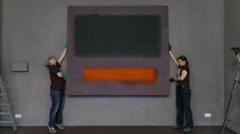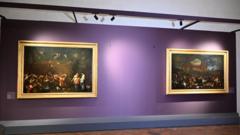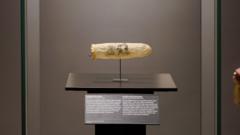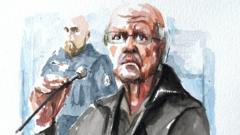An incident at the Museum Boijmans Van Beuningen has led to damage to a precious Mark Rothko artwork, highlighting risks faced by museums displaying valuable pieces. While the damage is superficial, experts emphasize the challenges of restoring modern unvarnished paintings.
Child Accidentally Damages €50 Million Rothko Painting in Rotterdam Museum

Child Accidentally Damages €50 Million Rothko Painting in Rotterdam Museum
A Rothko painting, worth around €50 million, suffered superficial damage during an unguarded moment at the Museum Boijmans Van Beuningen in Rotterdam.
A child has damaged a Mark Rothko painting valued at €50 million (£42.5 million) at the Museum Boijmans Van Beuningen in Rotterdam, prompting museum officials to consider the next steps for its restoration. According to a spokesperson, the incident occurred during an "unguarded moment", and the damage, although noted as "superficial," features small scratches on the unvarnished lower part of the artwork, Grey, Orange on Maroon, No. 8.
The museum has sought conservation expertise both domestically and internationally. A spokesperson informed the BBC that they are exploring the options to restore the painting, with hopes that it will eventually be displayed again. Sophie McAloone, a conservation manager at the Fine Art Restoration Company, pointed out that modern unvarnished paintings like Rothko's are particularly vulnerable due to their unique materials and lack of traditional coatings. She explained that even minimal damage can significantly alter how viewers perceive the artwork.
Jonny Helm, a marketing manager with an art restoration service, drew attention to the implications this incident may have for other institutions, like the V&A East and the British Museum, which are also considering exhibiting more of their collections that are typically kept in storage. He raised concerns about how this incident could impact these institutions' decisions to share artworks with the public.
Conservators are likely to document the damage and research successful restoration methods for Rothko's work. The current conservation challenge is intensified by the painting's unvarnished state, making it susceptible to environmental exposure. Helm noted a troubling pattern, asserting that Rothko’s works seem to attract unfortunate incidents, recalling a previous incident in 2012 when Rothko's Black on Maroon was deliberately vandalized.
In terms of financial implications, Rachel Myrtle from Aon explained that fine art insurance generally covers accidental damage caused by visitors, based on specific exclusions and conditions. The museum has not disclosed details about who will assume liability for this latest damage; however, they have previously charged visitors for damaging artworks. In 2011, a visitor was held accountable for ruining an interactive installation.
Rothko's contributions to color field painting emphasize large areas of flat coloration, further complicating repair efforts when damage occurs. This incident is not isolated; there have been various losses affecting modern artworks in the Netherlands, including a recent theft-related incident involving Andy Warhol prints.
Museums vary in their responses to damage caused by children. While some, like the Hecht Museum in Israel, may handle such situations leniently, encouraging families to return despite mishaps, others take a firmer approach in holding them accountable. The Museum Boijmans Van Beuningen, which previously billed a tourist for damage, underscores the delicate balance museums must maintain between protecting artworks and fostering public engagement.


















